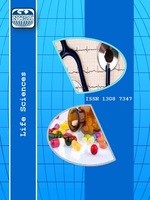PSATHYRELLA CONDOLLEANA VE PSATHYRELLA SPADICEOGRISEA'NIN ASPERGILLUS TÜRLERİ ÜZERİNDE ANTİFUNGAL AKTİVİTESİ
Bu çalışmada, Psathyrella türleri (P. candolleana, P. spadiceogrisea)’nin patojen mikrofunguslar Aspergillus (A. niger, A. versicolor) üzerine antifungal etkileri incelenmiştir. A. niger, A. versicolor, P. candolleana, P. spadiceogrisea sırasıyla malt ekstrakt agar ve nutrient broth besiyerlerinde üretildi. Çalışmada çözgen olarak etanol ve metanol kullanıldı. A. niger ve A. versicolor’dan ayrı ayrı olacak şekilde 1000 mikrolitre örnekler alınarak malt ekstrakt agar üzerine yayılarak kuruması beklendi. Üzerlerine disk difüzyon yöntemi ile steril distile su, etanol ve metanolde 48 saat muamele edilen P.candolleana ve P. spadiceogrisea emdirilmiş diskler su-etanol ve su-metanol şeklinde 2cm aralıkla bırakıldı. Karanlıkta, 27oC’de, 48 saat inkübe edildi. Psathyrella candolleana’nın her iki çözgeninin her iki Aspergillus türüne karşı antifungal etkisi görülmedi. Psathyrella spadiceogrisea’nın her iki çözgeninin her iki Aspergillus türüne karşı antifungal etkisi olduğu belirlendi.
Anahtar Kelimeler:
Psathyrella candolleana, Aspergillus, Psathyrella spadiceogrisea, Antifungal Etki
___
- • Ayodele, S.M. and Idoko, M.E., (2011). Antimicrobial Activities of Four Wild Edible Mushrooms in Nigeria. International Journal of Science and Nature. Vol:2(1), 2011:55-58.
- • Chelela, B.L., Chacha, M., and Athanasia, M.A., (2014). Antibacterial and Antifungal Activities of Selected Wild Mushrooms from Southern Highlands of Tanzania. American Journal of Research Communication. 2(9), 58-68.
- • Eren, E., Güler, P., and Kunduz, İ., (2013). Antifungal Effects of Leucopaxillus tricolor (Peck) Kühner Against to the Plant Pathogens, International Journal of Biology, Pharmacy and Allied Sciences, 2(2), 501-505.
- • Gbolagade, J.S. and Fasidi, I.O., (2005). Antimicrobial Activites of Some Selected Nigerian Mushrooms. African Journal of Biomedical Research. Vol:8, 83-87.
- • Guler, P., Kutluer, F., Erol, T., Eren, E., Kunduz, İ., and Biçer, H., (2012). Screening of Antifungal Effects of Pseudoclitocybe cyathiformis Bull. (Singer). International Journal of Applied Biology and Pharmaceutical Technology, Vol:3, Issue 1, Jan-Mar., 96-99.
- • Jonathan, S.G. and Fasidi, I.O., (2003). Antibacterial Activities of Nigerian Edible Macro Fungi Lycoperdon pusilum (Bat.Ex) and Lycoperdon giganteus (Pers.) African J. Biomed. Research, 6, 85-90.
- • Khatun, S., Islam, A., Cakilcioglu, U., Guler, P., and Chatterjee, N.C., (2015). Nutritional Qualities and Antioxidant Activity of Three Edible Mushrooms of Pleurotus spp. Wageningen Journal of Life Sciences. 72–73, 1–5.
- • Kirk, P.M., Cannon, P.F., Minter, D.W., and Stalpers, J.A., (2008), Dictionary of the Fungi (10th ed.). Wallingford, UK: CAB International. Pp:564. ISBN 978-0-85199-826-8.
- • Kuo, M., (2017). The Genus Psathyrella. Mushroom Expert. Com. http:// www. Mushroom expert.com (Access date: 06.09.2017). • Nedelkoska, D.N., Pančevska, N.A., Amedi, H., Veleska, D., Ivanova, E., Karadelev, M., and Kungulovski, D., (2013). Screening of Antibacterial and Antifungal Activities of Selected Macedonian wild mushrooms. Jour. Nat. Sci, Matica Srpska Novi Sad, No:124, 333—340.
- • Ocho-Anin, A.A.L., Farman, A.O., and Désiré, P.A.Y., (2017). Nutritional and Therapeutic Compounds of the Edible Dried Mushroom Psathyrella tuberculata and Prevention of the Arterial Hypertension Agric. Biol. J.N. Am., 8(1):10-17.
- • Owaid, M.N., Saleem, A.S.S., and Abed, A.I.S., (2017). Antifungal Activity of Cultivated Oyster Mushrooms on Various agro-wastes. Summa.
- • Smith, J.E., Rowan, N.J., and Sullivan, R., (2002). Medicinal Mushrooms: Their Therapeutic Properties and Current Usage with Special Emphasis on Cancer Treatments. University of Strathclyde, UK.
- • Stoke, J.E. and Ridgway, G.L., (1980), Clinical Bacteriology, Edward, Arnold Ltd. London.
- • Yangdol, R., Sharma, Y.P., Bhattacherjee, S., and Acharya, K., (2016). Molecular, Physical and Biochemical Characterization of an Edible Mushroom, Psathyrella spadicea (P. Kumm.) Singer, from Cold Desert of Ladakh, India. Current Research in Environmental & Applied Mycology 6(4):334–343.
- Başlangıç: 2009
- Yayıncı: Cevdet Emin EKİNCİ
Sayıdaki Diğer Makaleler
LAETIPORUS SULPHUREUS (BULL.) MURRILL’UN SİTOTOKSİTE, APOPTİK VE NEKROTİK ETKİLERİ
Aydın KESKİN, Perihan Güler, Mustafa Türk
HEMEN GÜL ERASLAN, Perihan GÜLER
SUILLUS COLLINITUS (FR.) KUNTZE’UN SİTOTOKSİTE, APOPTİK VE NEKROTİK ETKİLERİ
Ferit ARPAZ, PERİHAN GÜLER, MUSTAFA TÜRK
RUSSULA DELICA FR.’NİN SİTOTOKSİTE, APOPTİK VE NEKROTİK ETKİLERİ
